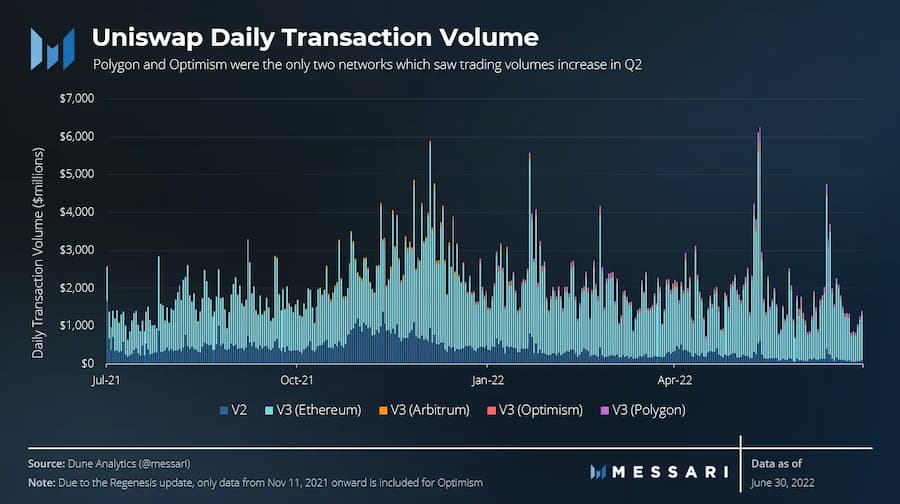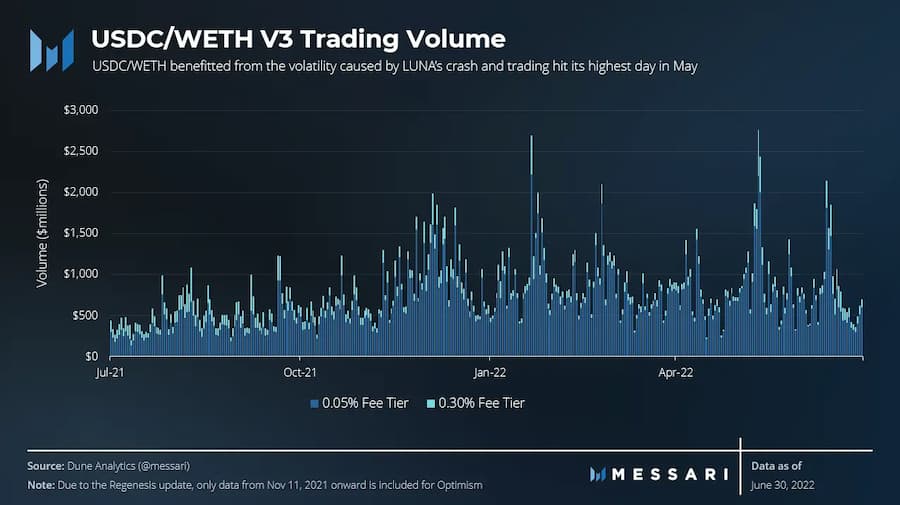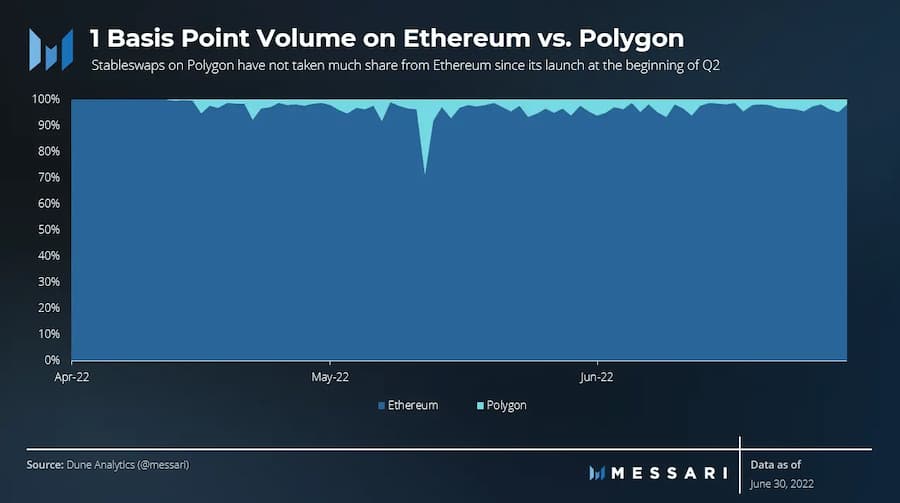Messari: Analyzing Uniswap's Market Performance and Progress in the Second Quarter
Written by: Jerry Sun, Messari researcher
Compiled by: Karen
Key Takeaways
Benefiting from market volatility and healthy arbitrage bot activity, Uniswap's trading activity in Q2 declined less than the overall cryptocurrency market.
Trading activity for WBTC increased as it served as collateral for distressed CeFi institutions.
Uniswap's grant program announced Wave 8 grant information.
Milestones for Uniswap in Q2 included the launch of a fee tier as low as one basis point (0.01%) on Polygon and the acquisition of the NFT marketplace aggregator Genie.

Macroeconomic Perspective

Despite a decline of over 50% in the cryptocurrency market capitalization in Q2, Uniswap's trading volume fell only 8.7% compared to the previous quarter, partly due to significant volatility in the crypto market; another important factor was the activity of arbitrage bots in the system, which accounted for 75% of all trading volume, indicating a healthy sign. DEXs have matured over the past two years to the point where activity is driven by price efficiency rather than purely retail speculation.

Additionally, liquidity provided on Uniswap decreased by 37.1% in Q2, outperforming the changes in cryptocurrency market capitalization. Considering that liquidity is largely influenced by the prices of underlying tokens, the decline in liquidity is not severe, especially compared to ETH prices, which fell nearly 70% during the same period.

Trading volume can be explored through liquidity provider (LP) fees. Compared to Q1, fees across all Uniswap networks decreased by 21.9%, except for Optimism. In contrast, LP fees on Optimism increased from $1.4 million to $3.5 million over the past 90 days, a rise of 146.9%.
The largest fee decline occurred on Arbitrum, where fees fell by 35.9% to $3.6 million in Q2. Although fees earned on Arbitrum in Q1 were four times that of Optimism, the $100,000 difference between the two in Q2 is negligible, further highlighting the impact of the OP airdrop in the Layer 2 scaling war. Whether Arbitrum will launch a token and how this will affect Uniswap's trading remains to be seen.
Microeconomic Perspective
Active V3 Markets
USDC/WETH

The overall trading volume of the "stablecoin/ETH" pairs on Uniswap V3 in Q2 remained roughly flat compared to the previous quarter; for example, the trading volume of USDC/WETH decreased by only 4.5% compared to Q1, although this was the first time the trading volume for this pair shrank on a quarter-over-quarter basis.
USDC/USDT

As previously mentioned, the introduction of the 1 bps (0.01%) fee tier made Uniswap's stablecoin exchange pools competitive. However, the trading volume of USDC/USDT decreased by 17.4% in Q2. Notably, the market panic triggered by the UST de-pegging spread to USDT, and the high trading volume during this period may have come from users seeking to exchange for USDC.

WBTC/WETH

The trading volume of WBTC/WETH in Q2 was more than three times that of Q1. As shown in the chart, several daily trading volume peaks in Q2 were nearly four times higher than at any other point in the past year. This was primarily due to CeFi loans typically being collateralized by BTC, with institutions like Luna Foundation Guard (LFG), Three Arrows Capital, Celsius, BlockFi, and Voyager having significant collateral exposure to BTC liquidating positions, or short sellers pushing prices to liquidation thresholds. Data provider Kaiko also noted that trading volume for WBTC pairs surged during this period, increasing nearly fivefold during the market crash in May 2021.
Active V2 Markets
The three most active markets on Uniswap V2 in Q2 were USDC/WETH, FXS/FRAX, and APE/WETH.
USDC/WETH
The trading volume of USDC/WETH increased from $2.7 billion in Q1 to $2.8 billion in Q2. Although the quarter-over-quarter increase was modest, it represented a significant decline compared to the $3.5 billion trading volume processed in Q3 2021. Trading fees remained relatively stable compared to Q1.

FXS/FRAX
The quarterly trading volume of the FXS/FRAX pool saw substantial growth, rising from $673 million in Q1 to $938 million. This was partly due to Terra's decision to include FRAX in the Curve 4pool, and on the other hand, the collapse of UST drove investors to be more cautious about algorithmic stablecoins.

APE/WETH

APE was airdropped to holders of BAYC and MAYC on March 17, reaching a trading volume peak of nearly $45 million on the first day after the airdrop, further driven by expectations of land sales.
Grant Program
The Uniswap grant program has deployed all funds allocated to the program, with the previous quarter's Wave 8 being the last round of project grants, with 230 applicants requesting a total of $900,000 in funding. Some highlight projects include:
GFX Labs ($50,000)
Uniswap Grants provided $50,000 to GFX Labs to research the best way to implement cross-chain governance for individual protocols.
DeFi Dev Course Creatio ($50,000)
Funding to create new courses focused on Web3 and DeFi on the learning platform Pursuit.
Uganda Blockchain Club ($15,000)
Aimed at funding computer science programs at 10 different universities in the country.
In June, Uniswap released its first Uniswap grant program report, stating that since the launch of UGP, it has provided approximately $7 million in UNI funding to 122 recipients, with the three largest project categories by number and allocation being sponsorships, tools, and community.
Key Protocol Updates
April 10, 2022: Deployment of a 1 basis point (0.01%) fee tier on Polygon
April 11, 2022: Launch of Uniswap Labs Ventures
May 15, 2022: Coinbase DApp integration
June 21, 2022: Acquisition of NFT marketplace aggregator Genie










